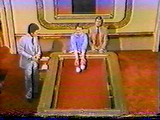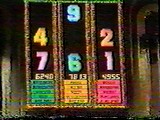High Rollers
From RulesWiki
| HIGH ROLLERS | |
| The logos for the 1978 and 1987 versions of High Rollers. | |
|---|---|
| Airdates: | NBC July 1974 - September 1976, NBC April 1978 - June 1980, Syn. September 1987 - September 1988 |
| Hosts: | Alex Trebek, Wink Martindale |
| Models: | Ruta Lee, Elaine Stewart, Leslie Uggams, Linda Kaye Henning, Becky Price, Lauren Firestone, KC Winkler, Crystal Owens |
| Announcers: | Kenny Williams, Dean Goss |
| Producers: | Heatter-Quigley Productions (1974-1980), Merrill Heatter Productions (1987-1988) |
Contents |
Gameplay
1974-1976 version
Two players competed. The host read a multiple-choice question, and the first player to buzz in would try to answer it. If correct, he could decide whether to play the dice (which were rolled by assistant Ruta Lee) or force his opponent to play them; if incorrect, the other player got this choice. A pair of dice were then rolled down the table, and the player then attempted to eliminate the numbers 1-9 by knocking them out according to the number rolled. (For example, if an 8 was rolled, the player could take off the 8 alone; the 5 and 3; or the 4, 3, and 1.)Behind each number was a prize which was added to the player's board when eliminated. One larger prize was split into halves between two different numbers; both numbers had to be knocked off by the same player for that person to be eligible for that prize. Play continued until either all nine numbers were eliminated or one player was disqualified for rolling an invalid number. The player who won the game won all the prizes on their board; if no prizes were available, he won $100. The first player to win two games advanced to the Big Numbers bonus round.
For a short period of time during the tail end of the run, each number concealed part of a portrait of a famous person. After each good roll, a player could guess the identity of the person, and won the game - along with any uncovered prizes - if successful. Upon a bad roll, the player's opponent was given a free guess. If the entire puzzle was revealed and neither player had a guess, the host would read clues to the person's identity until someone buzzed in and solved it.
In the Big Numbers, the player once again attempted to knock out the numbers 1-9 using the dice. Each number that was eliminated earned the player $100; if he managed to eliminate all nine numbers, he won $10,000. Early in the game, the $100 for each number knocked out was risked after each roll, with the money being lost if a bad roll was made.
1978-1980 version
The awarding of prizes underwent a change in the show's second version. In this run, the numbers were grouped into three columns of three each. At the start of each game, a prize was added to each column, up to a maximum of five prizes. To bank the prizes in a column, the player had to knock out the last digit in that column. One column (and in some cases, two) was dubbed the "hot column", as the total of its numbers were low enough that the entire column could be cleared with one roll, banking those prizes in the process.Players rolled their own dice in this version, and upon rolling doubles would earn Insurance Markers that extended the player's turn if a bad roll came up later in the game (or the roll just made was bad). As was the case before, a player had to win the game in order to win the prizes on his board; if the player had no prizes, he won $100 cash. The first player to win two games again advanced to the bonus round, where Insurance Markers were also offered for a roll of doubles. Winning the Big Numbers in this version won $5000 in cash and a new car.
1987-1988 version
The most recent run of High Rollers played very similarly to the 1978-1980 version, with one rule change with regards to the contents of each column. Instead of adding a prize to each column at the start of each game, columns now contained a different prize package in each game. One column often offered a mini-game involving one of the two dice. If a player cleared that column and won the game, they got to play the ensuing mini-game for a bonus prize, usually for a trip, a car, or an array of prizes. The winner of the match played the Big Numbers, now for $10,000 in cash. All other rules remained the same as in the 1978-1980 version.





